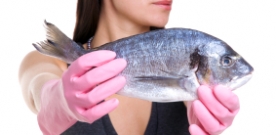Fishy Business – What’s the Deal With Seafood and Mercury?
By: Jodie Shield, RD
In my last blog, you read all about the health benefits seafood has to offer you and your family. But when it comes to mercury and food safety, things starts to (pardon the pun) smell a little fishy. Here’s why. Nearly all fish and shell fish contain traces of methylmercury – the most dangerous form of mercury. What is methylmercury? It is formed when mercury is released into the atmosphere from coal-burning power plants and other industrial pollutants. It falls from the air into surface water and eventually accumulates into steams and oceans. Bacteria in the water transforms mercury into methylmercury, which can be toxic. Fish absorb methylmercury as they feed in these contaminated waters. As a rule of thumb, the larger and older the fish, the higher their methylmercury content.
For most people, eating fish and shell fish is NOT a health concern. However, studies have found that high levels of methylmercury can harm an unborn baby or young child’s developing central nervous system. So the Food and Durg Administration (FDA) and Environmenatl Protection Agency (EPA) have issued an advisory for: women who might become pregnant, women who are pregnant, nursing mothers and young children regarding their consumption of seafood. Here are their recommendations.
- Do not eat Shark, Swordfish, King Mackerel, or Tilefish because they contain high levels of mercury.
- Eat up to 12 ounces (2 average meals) a week of a variety of fish and shellfish that are lower in mercury. Keep in mind that five of the most commonly eating fish are low in mercury: shrimp, canned light tuna, salmon, pollock, and catfish. Another commonly eaten fish, albacore (white) tuna has more mercury than canned light tuna. So, when choosing your two meals of fish and shellfish, you may eat up to 6 ounces of albacore tuna a week.
- Check local advisories about the safety of fish caught by family and friends in your local lakes, rivers, and costal areas. If no advise is available, eat up to 6 ounces per week of fish you catch from local waters, but don’t consume any other fish during that week.
- Follow these recommendations when feeding fish and shellfish to your young child, but serve smaller portions.
Sounds scary, but always keep in mind: the health benefits of eating seafood far outweight the mercury-risk. For more information about seafood and mercury visit the following web sites:
Also, my colleague Liz Ward, author of the American Dietetic Association’s Eating Expectantly, wrote an excellent blog on the topic of eating canned tuna without worring about mercury www.expectthebestpregnancy.com. So now you have the facts – any questions?






